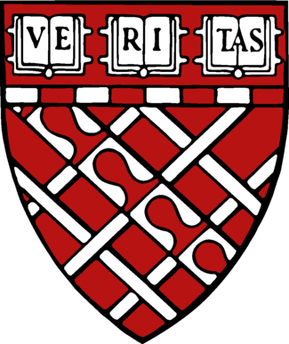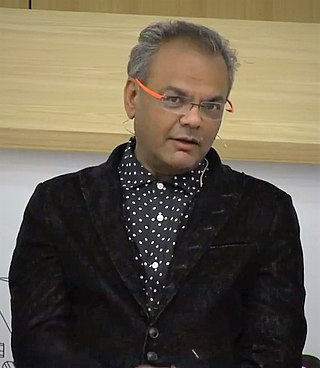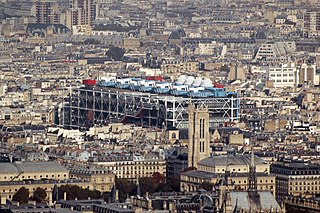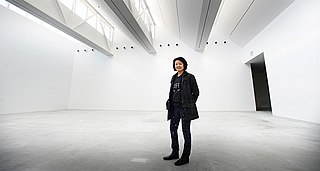
Biomimetics or biomimicry is the emulation of the models, systems, and elements of nature for the purpose of solving complex human problems. The terms "biomimetics" and "biomimicry" are derived from Ancient Greek: βίος (bios), life, and μίμησις (mīmēsis), imitation, from μιμεῖσθαι (mīmeisthai), to imitate, from μῖμος (mimos), actor. A closely related field is bionics.

Moshe Safdie is an Israeli-Canadian-American architect, urban planner, educator, theorist, and author. He is known for incorporating principles of socially responsible design throughout the course of his six-decade career. His projects include cultural, educational, and civic institutions; neighborhoods and public parks; housing; mixed-use urban centers; airports; and master plans for existing communities and entirely new cities in the Americas, the Middle East, and Asia. Safdie is most identified with designing Marina Bay Sands and Jewel Changi Airport, as well as his debut project Habitat 67, which was originally conceived as his thesis at McGill University. He holds legal citizenship in Israel, Canada, and the United States.

Tokyo Institute of Technology is a national research university located in Greater Tokyo Area, Japan. Tokyo Tech is the largest institution for higher education in Japan dedicated to science and technology, one of first five Designated National University and selected as a Top Type university of Top Global University Project by the Japanese government.

The Polytechnic University of Turin is the oldest Italian public technical university. The university offers several courses in the fields of Engineering, Architecture, Urban Planning and Industrial Design, and is consistently ranked as one of the best universities in Italy and in the world. As of 2024, it is ranked 28th worldwide for Mechanical Engineering, 22nd for Petroleum Engineering, 21st for Architecture and is among the top 100 (52nd) engineering and technology universities in the world.

The Harvard Graduate School of Design (GSD) is the graduate school of design at Harvard University, a private research university in Cambridge, Massachusetts. It offers master's and doctoral programs in architecture, landscape architecture, urban planning, urban design, real estate, design engineering, and design studies.

Chuck Hoberman is an artist, engineer, architect, and inventor of folding toys and structures, most notably the Hoberman sphere.

Jennifer A. Lewis is an American materials scientist and engineer, best known for her research on colloidal assembly of ceramics and 3D printing of functional, structural, and biological materials.

Christopher Charles Benninger is an Indian architect and urban planner. Born in the US, he permanently migrated to India in 1971. Benninger contributed to the field of critical regionalism and sustainable planning in India.

Kyoto Institute of Technology in Kyoto, Japan is a Japanese national university established in 1949. The Institute's history extends back to two schools, Kyoto Craft High School and Kyoto Sericulture Training School, which were forerunners of the Faculty of Engineering and Design and the Faculty of Textile Science, respectively. The former was moved to Sakyo-ku, Matsugasaki in 1930 and changed its name to Kyoto Industrial High School in 1944. The latter developed into Kyoto Sericulture High School, under supervision of the Ministry of Education in 1914, and changed its name to Kyoto Sericulture Technical High School in 1931 and then to Kyoto Technical High School of Sericulture in 1944. The two forerunners merged in 1949, due to educational system revisions, to establish the present School of Science and Technology. Together with Shinshu University and Tokyo University of Agriculture and Technology, the Institute is one of Japan's three historical centers of textile research.

Neri Oxman is an Israeli-American designer and former professor known for art that combines design, biology, computing, and materials engineering. She coined the phrase "material ecology" to define her work.

Donald E. Ingber is an American cell biologist and bioengineer. He is the founding director of the Wyss Institute for Biologically Inspired Engineering at Harvard University, the Judah Folkman Professor of Vascular Biology at Harvard Medical School and Boston Children's Hospital, and Professor of Bioengineering at the Harvard John A. Paulson School of Engineering and Applied Sciences. He is also a member of the American Institute for Medical and Biological Engineering, the National Academy of Engineering, the National Academy of Medicine, the National Academy of Inventors, and the American Academy of Arts and Sciences.

Seoul National University of Science and Technology is a national university located in Nowon-gu, Seoul, South Korea.

Hanif Mohamed Kara is a structural engineer and is design director and co-founder of London-based structural engineering practice AKT II. He has taught design internationally, is a member of the board of trustees for the Architecture Foundation and was a commissioner for CABE from 2008 to 2011. He is currently Professor in Practice of Architectural Technology at Harvard Graduate School of Design. He also taught as professor of Architectural Technology at KTH Royal Institute of Technology in Stockholm from 2009 until 2012. He lives in London with his wife and two daughters.

Architectural technology, or building technology, is the application of technology to the design of buildings. It is a component of architecture and building engineering and is sometimes viewed as a distinct discipline or sub-category. New materials and technologies generated new design challenges and construction methods throughout the evolution of building, especially since the advent of industrialisation in the 19th century. Architectural technology is related to the different elements of a building and their interactions; it is closely aligned with advances in building science.
Construction 3D Printing (c3Dp) or 3D construction Printing (3DCP) refers to various technologies that use 3D printing as a core method to fabricate buildings or construction components. Alternative terms for this process include "additive construction." "3D Concrete" refers to concrete extrusion technologies whereas Autonomous Robotic Construction System (ARCS), large-scale additive manufacturing (LSAM), and freeform construction (FC) refer to other sub-groups.

Toshiko Mori is a Japanese architect and the founder and principal of New York–based Toshiko Mori Architect, PLLC and Vision Arc. She is also the Robert P. Hubbard Professor in the Practice of Architecture at the Harvard University Graduate School of Design. In 1995, she became the first female faculty member to receive tenure at the GSD.
The Harvard Laboratory for Computer Graphics and Spatial Analysis pioneered early cartographic and architectural computer applications that led to integrated geographic information systems (GIS). Some of the Laboratory's influential programs included SYMAP, SYMVU, GRID, CALFORM, and POLYVRT. The Laboratory's Odyssey project created a geographic information system that served as a milestone in the development of integrated mapping systems. The Laboratory influenced numerous computer graphic, mapping and architectural systems such as Intergraph, Computervision, and Esri.
Jenny E. Sabin is an American architect, designer and artist who draws upon biology and mathematics to design material structures. Sabin is the Arthur L. and Isabel B. Wiesenberger Professor of Architecture in the Department of Architecture at Cornell University. She focuses on design and emerging technologies, with particular emphasis on the areas of computational design, data visualization and digital fabrication.
Miho Mazereeuw is an Associate Professor of Architecture and Urbanism in the Department of Architecture at MIT where she also directs the Urban Risk Lab. Mazereeuw is most known for her work in disaster risk reduction.

The TUM School of Engineering and Design is a school of the Technical University of Munich, established in 2021 by the merger of four departments. As of 2022, it is structured into the Department of Aerospace & Geodesy, the Department of Architecture, the Department of Civil & Environmental Engineering, the Department of Energy & Process Engineering, the Department of Engineering Physics & Computation, the Department of Materials Engineering, the Department of Mechanical Engineering, and the Department of Mobility Systems Engineering.















